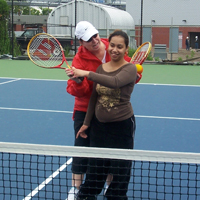Bringing History to Life: How Larry Swiader ’89, G’93 Blends Storytelling With Emerging Technology
Instructional design program alumnus Lawrence “Larry” Swiader ’89, G’93 has built a career at the intersection of storytelling, education and technology—a path that’s taken him from the early days of analog editing as a student in the S.I. Newhouse School…


 Modeled after perceptual-motor programs, including the internationally known movement education program by Jack Capon, the Inclusion Tennis Program (ITP) began at SU this past spring. Orton was encouraged by the suggestion from Corinne Smith, professor and chair of teaching and leadership, to design a physical activity course where all students were included as true participants and could participate in learning, teaching and demonstration activities. With assistance from Joe Lore, director of SU Recreation Services, and Eliza Decker, assistant director, who accommodated off-campus individuals and provided gym space whenever needed, this innovative and collaborative program was launched.
Modeled after perceptual-motor programs, including the internationally known movement education program by Jack Capon, the Inclusion Tennis Program (ITP) began at SU this past spring. Orton was encouraged by the suggestion from Corinne Smith, professor and chair of teaching and leadership, to design a physical activity course where all students were included as true participants and could participate in learning, teaching and demonstration activities. With assistance from Joe Lore, director of SU Recreation Services, and Eliza Decker, assistant director, who accommodated off-campus individuals and provided gym space whenever needed, this innovative and collaborative program was launched.